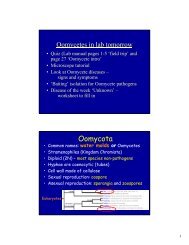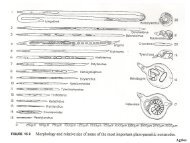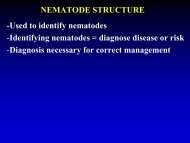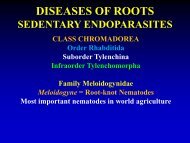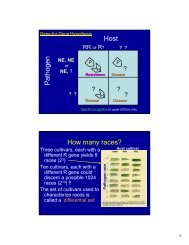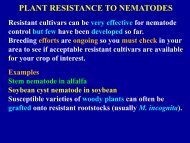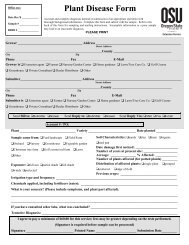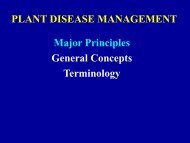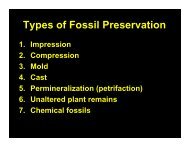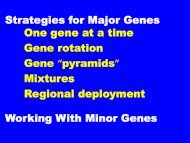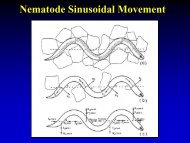Create successful ePaper yourself
Turn your PDF publications into a flip-book with our unique Google optimized e-Paper software.
Variations in Holophagic FeedingA - PanagrellusB - AscarisC - AplectanaPumping rate = 1-5/sec, bursts = 20/sec
Nematode Esophageal TypesKathy Merrifield
www.fcps.k12.va.us
Some nematodes pierce the cuticle of preywith a stylet, inject enzymes and ingestthe internal body fluids. (Seinura sp.)Fluid-FeedingPredators
Fluid-FeedingFungal Feeders
Fluid-FeedingPlant FeedersScott EdwardsU. Wyss
Fluid-FeedingPlant FeedersLocating HostExploration = find roots by chanceAttraction = respond to gradients in:CO 2exudatesrhizosphere microbial productsAttraction may reach ½ meter> mile in human scaleU. Zunke
Fluid-FeedingPlant FeedersLocating Feeding Site- Exploration of root = probe w/o puncturing- Head rocks side to side, papillae touch root- Arches body to bring stylet at right anglesto root for maximum thrust- Polysaccharide plug may gluelips to root
Fluid-FeedingPlant FeedersStylet Penetration-Nematode penetrates cell wall with stylet-Only part of stylet used so many thrustsrequired, up to 2-6 thrusts/sec-Nematode may move head back and forth-Show film clip
Fluid-FeedingPlant FeedersIngestion-Pause after stylet penetration (1)-Enzymes may be secreated intocell for predigestion (2),20 sec-2 hrs, cyclosis may stop-Medan bulb pumps cell contentsinto esophagus (3)-Turgor pressure in cell may assist-Cell may collapse (4)-Feeding time/cell 1-5 min to 1 wk
Fluid-FeedingPlant FeedersIngestion-In other cases cyclosis may continue whilecell is fed upon-Cell not damaged
Fluid-FeedingPlant Parasites - InvasionMigratory ectoparasites – withdraw stylet, move tonew cell, & repeat processEndoparasites – penetrate further into tissuesRoot-knot J2 collect behind apical meristem,perforate epidermal cell with stylet until cell wallcollapses, push head inside = 3-24 hrsHigh populations = competition for invasion sites.J2 may follow in the same hole, enlarging it and thehole may become surrounded by necrotic cells.
Fluid-FeedingPlant Parasites - InvasionW. Wergi
Fluid-FeedingPlant Parasites - InvasionEnter through natural openings-Lenticels in potato tubers-Junctions between primary and lateral roots-Stomata in leaves
Fluid-FeedingPlant Parasites - Tunneling-“Cut” holes through cell walls with stylet- Force between cells = “unzip” middle lamella(Root-knot, Meloidogyne)- Digest holes through cell walls with enzymes(Burrowing nematode, Radopholus similis)
Fluid-FeedingPlant Parasites - TunnelingMovement through the root is periodic as thenematode occasionally stops to feed.D. Wixted
Fluid-FeedingPlant Parasites - FeedingEndoparasites disrupt tissuesduring feedingEnzymes secreted = tissuesenlarge, separate & collapse toform cavities (D)Specialized feeding cells areformed(E) = nurse cells(F) = giant cells
Animal ParasitesDiscuss Later
Nematode Reproduction“Sex of an individual depends on gamete produced”Sperm = maleEggs = femaleBoth = hermaphroditeEggs embryo w/o sperm = parthenogenic femaleNematodes are extremely varied in theirpatterns of reproduction.
Nematode ReproductionAmphimixis = eggs and sperm come fromseparate individuals during cross fertilizationwhere male deposits sperm in reproductivetract of female. Most common typeMales with a bursa align “parallel” to femaleMales without bursae align “perpendicular”to the female's body and the entire posteriorregion folds over and grasps the vulva.“Cement” may hold nematodes together.
Nematode ReproductionAmphimixisSex attractants aid males and females to findeach other.Sedentary = only females produceMigratory = both sexes produce & respond
Nematode ReproductionUnder normal conditions, most amphimicticpopulations maintain a 1:1 sex ratio.Stress in environment can alter the sex ratio.Usually the response is to inadequate nutrition.Developing population = predominantly male.Differential survival, more female mortality.High temperatures, increased CO 2 andaccumulation of certain chemicals may alsoincrease the ratio of males to females.
Nematode ReproductionAutomixis = self fertilization by hermaphroditesEgg and sperm come from same individualSyngonic hermaphrodites = eggs and spermproduced in the “same gonad” ovotestis.Sperm produced first, stored while eggs areproduced. Fertilized as move towards uterus.Diagonic hermaphrodites have “separatestructures” for producing eggs and sperm.Different gametes produced at same time.
Nematode ReproductionPseudomixis (pseudogamy)Participation of male gamete necessary foroocyte development but no fertilization.Facultative pseudogamy = unfertilized eggsbecome males, fertilized eggs become females.Redundant pseudogamy = sperm is depositedin reproductive tract but doesn't penetrate egg.
Nematode ReproductionParthenogenesis = “females beget females”Reproduction from unfertilized eggs withoutparticipation of a male gamete.Mitotic parthenogenesis = Retains the somaticnumber of chromosomes = no pairing ofhomologous chromosomes during prophase.Oocytes remain diploid.(n 2n without cell division= mitosis without cytokinesis)
Nematode ReproductionParthenogenesis = “females beget females”Meiotic parthenogenesis = two maturationdivisions = Results in eggs that are haploid.Diploid condition restored by fusion of eggnucleus with nucleus of nonextruded polar body.Facultative meiotic parthenogenesis occurs innoninseminated females or non-fertilized eggs.Fertilized eggs = amphimictic development.Both processes can occur in same female.
Nematode Reproduction
Nematode ReproductionOviparous = eggs releasedOvoviviparous = living young releasedEndotokia matricida = eggs hatch in uterus,juveniles burrow through the uterus into thebody cavity and feed on body of the mother.
Nematode ReproductionMigratory nematodes = eggs move down theovary into the uterus and are laid one at a timeas soon as they reach the vulva.Sedentary parasites lay eggs in a cluster eitheroutside (root-knot) or inside (cyst) the body.Most nematodes lay eggs in the soil butendoparasites lay eggs in the soil or insideplant tissues.
Juveniles develop within egg,may go through one or twomolts before hatching.Most hatch spontaneously assoon as they reach the end ofembryonic development.Temperature and moistureregulate developmental time.Some plant parasites needstimulus such as elevatedCO 2 , or root exudate totrigger hatching sequence.Some species require diapause
During the hatching process, either the shell issoftened by enzymes, or the nematode uses its styletto puncture a hole in the shell.



